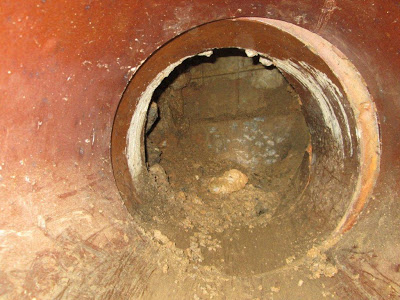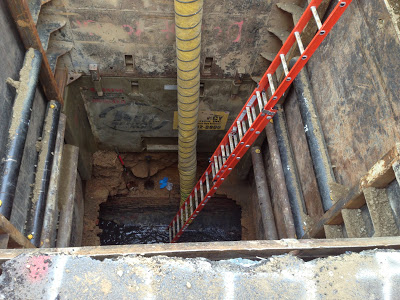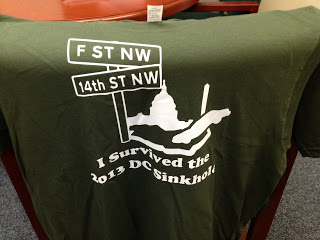The call seemed innocent enough at first -- a question over a small hole that was visible at the edge of a steel plate near the curb at 14th and F Street. From that call, however, came a dramatic example of one of the biggest challenges facing water infrastructure. And no, it is not just about how old it is, although that is a huge issue. In this case, the biggest challenge is how to unscramble, or even know, what is under the streets. Water and sewer mains are down there for sure, but there is so much more.
In short, the "sink hole" (not really the right term, as I will describe) at 14th and F Streets NW -- one block from the White House and on a major traffic corridor -- was triggered by elements of the road breaking off underneath the street and falling through the top of the 54" sewer main that was beneath.
The Damaged Brick Sewer Line
When the sewer collapsed, a brick structure built in 1897, that triggered a wider cave-in - hence the "sink hole." However, this was not a sink hole due to natural conditions that have been reported in Florida and other states. Rather, the street was undermined and a void was opened. The principle question is why?
The answer to this question surprised us -- and was not apparent until we had opened up the street. The road was undermined by stormwater from a pipe that was designed to transport rainwater flowing off the street from the storm drain at the Northwest corner of 14th and F to the deep sewer.

Stormwater Pipe Blocked by a Communications Manhole
Apparently, a communications manhole was installed that was driven right through the stormwater pipe, effectively cutting off the flow to the sewer itself. Instead, the rainwater in every storm was flowing out of the pipe into the dirt underground, eroding the material beneath the street -- probably then seeping into the ground or the sewer pipe and being carried away.
Our best hypothesis at this time is that the communications manhole was installed sometime in the 1990s, during a spasm of work that was done to install fiber optic cable. At the time, the District did not have strong safeguards to manage utilities drilling in the streets. In this time frame, not only was our stormwater pipe obstructed, but our pre-existing manhole to allow us to check the line was also paved over. Not a good combination obviously -- and one that ensured we did not know we had a problem until the hole opened from below.
- We had to cut through old trolley tracks in order to get into the street.
- We found Pepco, Washington Gas, Verizon, ATT and other associated lines in the Street. On two occasions, the location of the underground utilities was not where it was indicated on the maps we use to mark before we dig. In one case, we almost ruptured a gas main that apparently had been moved during a private building project but was not changed on the street maps. We often had to stop work to ensure safety, and on several occasions were digging by hand to avoid mishaps.
- We also found unidentified communications vaults that are likely associated with the federal buildings in close proximity -- perhaps even communications lines to the U.S. Treasury and White House.
- Our sewer lines are between 15 and 20 feet below the surface, and are underneath everything else. To get to our collapsed sewer is a complicated puzzle to painstakingly reroute other utilities before we can dig and fix ours.
- Fixing our 54 inch sewer meant cutting 2 foot pieces of steel pipe and rewelding them together underground inside the broken sewer -- essentially lining the existing tunnel. The pieces had to be specially cut so that connections to the existing sewer laterals could be maintained.
Folks should understand the incredible complexity of fixing what is underneath our feet, and the careful step-by-step process that is needed to undertake these excavations without rupturing some other type of service. Particularly if past work obstructs the existing system, we will have failures regardless of the age of the system. Then, nearly $5 million later in this case, we can get our system back up to the condition we all tend to think we have in the first place.
Cross-posted from George S. Hawkins' blog


